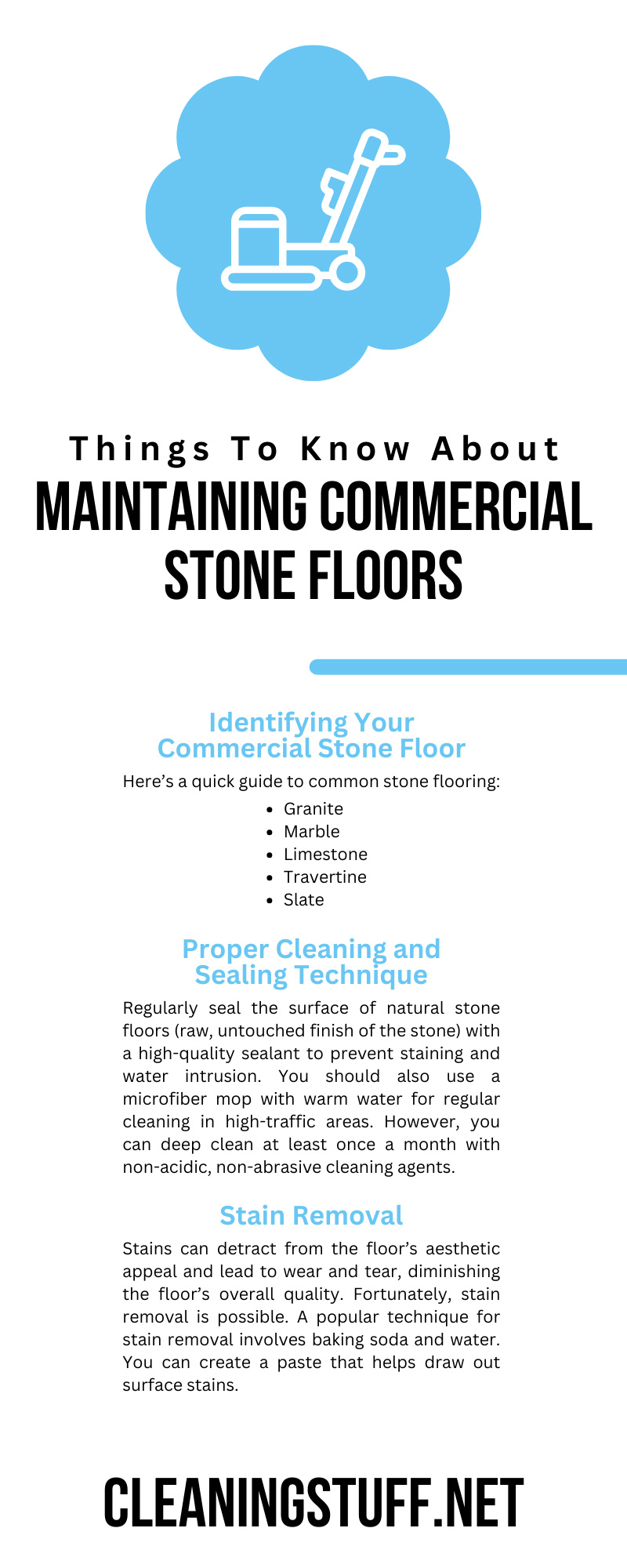8 Things To Know About Maintaining Commercial Stone Floors
14th Mar 2024
Commercial stone floors have aesthetic appeal and exceptional durability. However, maintaining the beauty and sustaining the life of these floors requires understanding and effort. Let’s explore some important things to know about maintaining commercial stone floors.
Types of Commercial Stone Floors
Commercial stone floors refer to flooring surfaces made from natural stone. These floors can feature a variety of materials, including granite, marble, limestone, travertine, and slate. Each type has its unique characteristics and common uses.
For example, granite is known for its durability and is popular in high-traffic areas, whereas marble offers a touch of sophistication and is ideal for lobbies and reception areas. Furthermore, limestone is known for its natural, earthy appeal, making it a great choice for warm and inviting spaces like entrance foyers and communal gathering areas.
Understanding the type of stone floor you have is the first step toward effective maintenance. The proper care and maintenance techniques can vary based on the specific stone material. For instance, granite may require different cleaning and sealing methods than marble or limestone.
Therefore, identifying the type of stone floor in a commercial space is crucial for implementing the appropriate maintenance practices to preserve its beauty and longevity.
Identifying Your Commercial Stone Floor
As mentioned, understanding your facility’s floor type is important. Here’s a quick guide to common stone flooring:
- • Granite: This stone’s appearance is speckled and granular, often featuring various colors and patterns. It typically exhibits a coarse and crystalline texture. It’s also known for its hardness and resistance to scratches and heat.
- • Marble: This stone has various veining patterns and comes in a range of colors, including white, gray, and pink hues. It exhibits a smooth and elegant surface texture. However, marble is relatively softer and more porous than granite.
- • Limestone: This stone offers a natural, earthy appearance with muted tones and occasional fossil imprints. It has a soft and chalky texture that may contain visible shell or mineral fragments. It’s softer than granite and marble, making it more susceptible to wear and etching.
- • Travertine: This stone features a unique blend of earthy tones, often displaying a porous and textured appearance with natural pits and voids. However, it’s porous and requires special care to prevent staining and etching.
- • Slate: This stone often comes in rich, deep colors such as dark gray, black, green, and copper, with a distinct cleft texture. It showcases a fine-grained and foliated texture, offering a rustic and natural aesthetic. It’s highly durable and resistant to water absorption.
Proper Cleaning and Sealing Technique
Employing specific cleaning and sealing techniques tailored to each material’s characteristics is important when maintaining various types of commercial stone floors.
Regularly seal the surface of natural stone floors (raw, untouched finish of the stone) with a high-quality sealant to prevent staining and water intrusion. You should also use a microfiber mop with warm water for regular cleaning in high-traffic areas. However, you can deep clean at least once a month with non-acidic, non-abrasive cleaning agents.
Apply a quality sealant to polished stone floors to maintain the polished surface and prevent damage from stains. Furthermore, use a dry microfiber mop daily and a wet mop once a week to keep the floor in optimal condition.
For unpolished stone floors, prioritize regular cleaning and sealing to ensure longevity and resistance to wear. Clean these floors daily with a dry microfiber mop and use gentle materials for deeper cleaning when necessary.
Stain Removal
Stains can detract from the floor’s aesthetic appeal and lead to wear and tear, diminishing the floor’s overall quality. Fortunately, stain removal is possible. A popular technique for stain removal involves baking soda and water. You can create a paste that helps draw out surface stains.
Deep-seated or more stubborn stains may require intensive treatment. Moreover, the restoration process for commercial stone floors often includes rehoming the stone to remove deep scratches, followed by repolishing to achieve a pristine finish.
Addressing Spills
Immediate action is necessary when spills occur to prevent staining or damage to the stone. Promptly clean up any spills using a clean cloth or mop to prevent the liquid from seeping into the floor. Use warm water and a mild detergent to gently clean the area for non-acidic spills, such as water or coffee. You can also use a soft, clean cloth to wipe up the spill.
Consider placing mats in the affected area if you notice recurring spills. The material will soak up the liquids before they reach the flooring.
Polishing Techniques
Using Cornerstone Floor Sealer and Finish is one way to polish commercial stone floors. Apply the product evenly across the floor. Start in the furthest corner of the room and move toward the exit, ensuring you cover all areas. Then, allow it to dry.
After drying, use a high-speed machine (1500 to 2000 RPM) with a burnishing pad. Burnishing will polish the floor, bringing out its natural shine while enhancing the protective properties of the Cornerstone Sealer and Finish.
Additionally, using a slow-speed buffing machine with a diamond pad can enhance the stone’s visual appeal by adding a highly reflective gloss to the floors. Regardless of your method, stone floor polishing tools can help you achieve your desired results.
Preventive Maintenance Practices
Preventative maintenance is an essential thing to know about maintaining commercial stone floors. It helps preserve the floor’s appearance and durability. Here are some best practices to follow:
- • Daily dust mopping: Use a dry dust mop daily in high-traffic areas to remove dirt buildup, dust, and debris. This first step prevents the accumulation of abrasive particles that can cause wear and tear over time.
- • Regular sweeping or vacuuming: Sweep or dust-mop the stone flooring daily to remove dirt or grit that can scratch or dull the surface. Additionally, using a vacuum cleaner without a beater bar can help maintain the floor’s cleanliness.
- • Use mats and rugs: Placing mats or rugs in high-traffic areas can minimize direct foot traffic and the accumulation of dirt and grit on the stone surface.
Performing Inspections
Businesses can ensure a safe, visually appealing, and well-maintained environment for employees, customers, and visitors by conducting regular floor inspections. Proper inspections contribute to the flooring’s preservation, creating a favorable impression for all who enter the facility.
Identify potential issues such as uneven surfaces, wear and tear, or the presence of slippery substances that could pose safety hazards to occupants and visitors. Address any problems that arise promptly to prevent accidents and maintain a high standard of safety within the premises.
Final Thoughts
Maintaining commercial stone floors demands a proactive approach, from understanding the specific care needs of stone to implementing regular cleaning and preventive measures. You can ensure your stone floors remain a stunning reflection of the facility for years to come by educating yourself on these essential maintenance practices.


